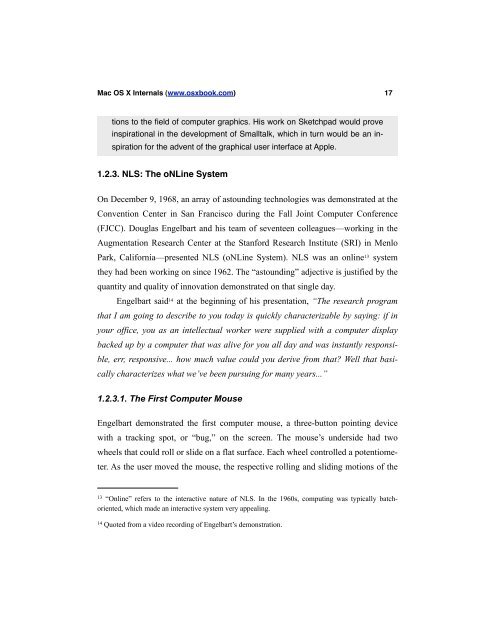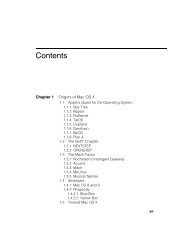A Technical History of Apple's Operating Systems - Mac OS X Internals
A Technical History of Apple's Operating Systems - Mac OS X Internals
A Technical History of Apple's Operating Systems - Mac OS X Internals
Create successful ePaper yourself
Turn your PDF publications into a flip-book with our unique Google optimized e-Paper software.
<strong>Mac</strong> <strong>OS</strong> X <strong>Internals</strong> (www.osxbook.com) 17<br />
tions to the field <strong>of</strong> computer graphics. His work on Sketchpad would prove<br />
inspirational in the development <strong>of</strong> Smalltalk, which in turn would be an in-<br />
spiration for the advent <strong>of</strong> the graphical user interface at Apple.<br />
1.2.3. NLS: The oNLine System<br />
On December 9, 1968, an array <strong>of</strong> astounding technologies was demonstrated at the<br />
Convention Center in San Francisco during the Fall Joint Computer Conference<br />
(FJCC). Douglas Engelbart and his team <strong>of</strong> seventeen colleagues—working in the<br />
Augmentation Research Center at the Stanford Research Institute (SRI) in Menlo<br />
Park, California—presented NLS (oNLine System). NLS was an online 13 system<br />
they had been working on since 1962. The “astounding” adjective is justified by the<br />
quantity and quality <strong>of</strong> innovation demonstrated on that single day.<br />
Engelbart said 14 at the beginning <strong>of</strong> his presentation, “The research program<br />
that I am going to describe to you today is quickly characterizable by saying: if in<br />
your <strong>of</strong>fice, you as an intellectual worker were supplied with a computer display<br />
backed up by a computer that was alive for you all day and was instantly responsi-<br />
ble, err, responsive... how much value could you derive from that? Well that basi-<br />
cally characterizes what we’ve been pursuing for many years...”<br />
1.2.3.1. The First Computer Mouse<br />
Engelbart demonstrated the first computer mouse, a three-button pointing device<br />
with a tracking spot, or “bug,” on the screen. The mouse’s underside had two<br />
wheels that could roll or slide on a flat surface. Each wheel controlled a potentiome-<br />
ter. As the user moved the mouse, the respective rolling and sliding motions <strong>of</strong> the<br />
13 “Online” refers to the interactive nature <strong>of</strong> NLS. In the 1960s, computing was typically batch-<br />
oriented, which made an interactive system very appealing.<br />
14 Quoted from a video recording <strong>of</strong> Engelbart’s demonstration.




